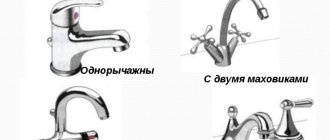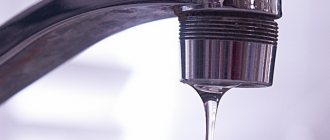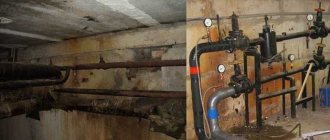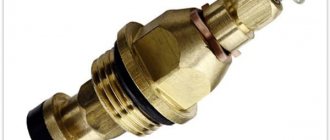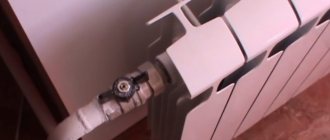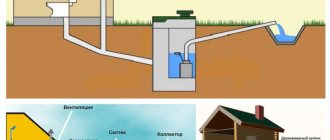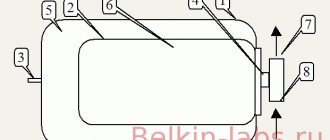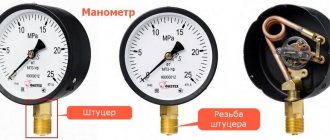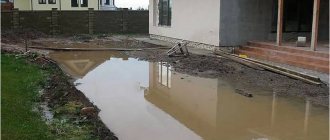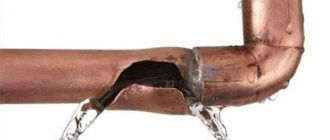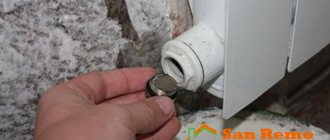Different types of plumbing fixture failures manifest themselves in different ways. Some, such as leaks, are immediately visible. Other faults do not manifest themselves so clearly. For example, when the faucet in the bathroom hums, many do not attach any importance to it, attributing this circumstance to some third-party reasons. But humming, whistling and other sounds from plumbing are not normal and most often indicate a faulty faucet or other problems in the plumbing system.
Nature of noise in the pipeline
At first glance, all unpleasant sounds have a common nature. But in fact, noises have a different range and character. And this means completely different reasons for their occurrence. And if we delve deeper into the problem, it turns out that even the same sound can have different origins.
Constant hum
When trying to figure out why pipes are humming, you need to focus on the type of sound while simultaneously trying to find its source. And having compared all the factors and hypothesized the cause, you can begin to eliminate the problem. And most often, such long-term noise is observed in old buildings that have not had a major overhaul of the plumbing.
Basement pipeline Source gazeta-n1.ru
There can be several reasons for continuous sounds:
- Most often, noise occurs in the basements of high-rise buildings, where the centralized water main is laid from steel pipes. And corrosion most quickly destroys the attachment points. The rigidity of the pipeline's position is broken and it begins to move.
- Sometimes noise appears immediately after a major system overhaul. This indicates errors in the location of the pipes. And also about poor-quality fasteners.
- It happens that a flanged valve is installed against the flow.
- It is possible that a smooth transition from a larger pipe diameter to a smaller one is not ensured. And too sharp a difference creates turbulence in the flow.
- The fault may be faulty valves with loose or worn cone locks.
- Compression couplings at line joints may become loose.
- The reason can be found in the apartment itself. It happens that the connection between the mixing fittings and the water socket is made poorly.
These are the most serious problems that the owner often cannot cope with on his own (except for the last point). And to eliminate the reason why the faucet is humming, you will need to involve specialists and undergo serious repairs.
Water supply repair Source vyksa.rf
See also: Catalog of companies that specialize in water supply, sewerage and related work
Humming turning into whistling
A whistling noise occurs in pipes when the water flow is not completely blocked by the valves. But a similar problem can arise due to a simple blockage. And in steel pipes that have not been replaced for a long time, permeability may decrease due to lime deposits.
Tapping
The location of the knock in the pipeline can be determined with high accuracy. Such clear localization makes it possible to quickly find the cause, unlike previous cases. Which means we should start eliminating it as soon as possible.
Knocking in pipes can occur for several reasons:
- In a hot pipeline, expansion of the walls occurs. They begin to come into contact with surrounding objects.
- The valve on the locking rod in the valve box has come off.
- The pipeline contains air pockets.
Dealing with such problems does not require professionalism. They are not difficult to eliminate yourself.
Noise with vibration
Pipes in the riser hum and vibrations occur for the following reasons:
- The rubber gasket on the faucet axle has completely worn out.
- Either the mixer is faulty, or it is poorly connected to the water supply.
- There is too much pressure in the pipeline.
Faulty faucet Source roomester.ru
How to replace a beaker with your own hands?
Every modern faucet has a tap, which is necessary to shut off the flow of water. Depending on the design of the device, it can be ceramic or with a rubber gasket. When noise, whistling and rattling noises begin to be heard when turning on the water, it is necessary to remove the weighing bottle, assess its condition, and then replace or clean it.
To remove this element from the mixer, you must follow the following algorithm:
- First, you need to turn off the water supply to the apartment using ball valves so that the valves do not break off or leak during operation.
- The next stage of dismantling is unscrewing the protective cap from the “lamb”, that is, the handle, the rotation of which regulates the water pressure.
- After removing the protective cap, use a Phillips screwdriver of the required size to unscrew the support screw.
- When the support screw is removed, use a plumbing adjustable wrench to unscrew the jug from the mixer.
If a bottle with a gasket is removed from the mixer, then you need to assess the degree of its wear. This is very simple to do: if the rubber has become hard and does not bend, has become “stiff,” then the gasket has become unusable and must be replaced with a new one. If the rubber remains elastic and resilient, then to eliminate noise in the tap you need to carefully trim its edges at an angle of 45 degrees.
Remember! Most often, bottle failure occurs due to poor quality tap water or due to the tap being pulled too tightly during use. To increase the service life of the faucet, you can install a coarse filter, which purifies the water from large impurities that clog the shut-off valves of the mixer.
Cups made of metal ceramics rarely break, as they are made from materials that are not subject to deformation. In addition, the principle of their operation is based on the precise fit of the parts of the locking mechanism. If a breakdown does occur, the reason is the silicone gasket between the ceramic plates.
To eliminate the problem of noise from the tap in this situation, you need to replace the ceramic bottle with a new one. To do this, the easiest way is to first unscrew the broken one, run with it to the store to buy a similar one, and then reassemble the mixer in the reverse order, not forgetting about the fum tape.
Causes of noise in pipes
When trying to figure out why a faucet is noisy or pipes are humming, it is necessary to remember the physical nature of all processes. The flow passing through the pipe not only puts pressure on its walls, but also affects them thermally or chemically. And since everything is subject to aging, you need to perceive noise as a signal of an imminent accident.
High pressure
The water pipeline is designed to withstand significant pressure. Therefore, it easily withstands its maximum increase to 6 atmospheres. This is the maximum standard for cold water supply that can be supplied to a residential building. For hot water it is less and is 4.5 bar.
But, as a rule, a pipeline of large diameter pipes is laid to the house. And throughout the building, wiring is done from much smaller pipes. It is at the moment of transition from the street pipeline to the home one that the flow speed increases. And Bernoulli’s law tells a good story about this.
Transition from a large diameter to a smaller one Source domhitrosti.ru
When the shower hose leaks
In most cases, the shower hose begins to leak precisely at the point where it connects to the faucet. Most often, leakage is associated with loose nuts. To start, try simply tightening the nuts tighter - sometimes this is enough to stop the leak.
If this does not stop the leak, it may be due to worn gaskets. In this case it is necessary:
- Unscrew the hose clamping nut.
- Remove the unsuitable gasket.
- Install a new cartridge.
- Apply two layers of insulating tape.
- Screw the nut into place.
If your hose has exceeded 15 years of service life, it is recommended to purchase a new shower kit. Towards the end of its service life, plumbing fixtures often begin to break down, and sometimes it is wiser to buy a new set than to repair the old one several times.
Although broken plumbing fixtures can be a huge inconvenience, many of these problems are easily remedied. In most cases, the owner can handle it on his own. However, in case of serious damage or difficulties in repairing it yourself, it is strongly recommended to call a specialist, because working plumbing is not only convenient and economical, but also safe.
Briefly about the main thing
Humming in water pipes can be divided into two categories. Those that occur in highways and risers. And which happen within the apartment itself. In the first case, either management companies or building management are responsible for the problems. And they can be solved with the help of professional plumbers.
If the problem is with taps or mixers, then the breakdown can be repaired yourself. But when you lack confidence in your abilities, it is better to call a specialist. Such repairs are not a global problem and will be relatively inexpensive.
Ratings 0
When the shower gander switch leaks
In order to switch the water supply from the shower to the gander and back, we use a special lever. Sometimes it leaks too. What to do in this case?
As with most cases, the most likely source of the problem is a worn gasket. In order to fix the problem, you need to:
- Unscrew all screws and bolts from the lever (if they are missing, simply unscrew the lever from the mount).
- Remove the lever, remove the gasket, replace it.
- Place the lever back and, if there are screws, tighten them.
Ready! The switch no longer leaks.
Diagnosis of the problem
The reason for the hum in the pipes is turbulence of the flow, which appeared due to a leak in the connections of the plumbing elements. Leaks that occur in shut-off valves change the cross-sectional area of free passage inside the pipe space. This is how vortices appear that hum.
Air leaks due to leaks cause a series of hydraulic shocks, which cause vibration of the pipes. It often accompanies annoying sounds similar to a honking train.
Methods for clearing blockages
You are mistaken if you think that you just need to pour some unique liquid like “Mole” into the system and the problem will be solved. You'll have to work on your own. The blockage can be cleared in three ways:
- Hydraulic flushing.
- Pneumatic flushing.
- Mechanical cleaning.
Let's look at the flushing option first. This is the passage of water flow. To do this, it is not enough to simply connect a hose, so they use electric, fairly powerful pumps. However, this method can only remove blockages in small-diameter pipes. This method is not suitable for thick products. In this case, heavy particles will still have time to settle on the walls.
If a single-lever type of faucet is humming
If your faucet with a cartridge inside is humming, that is, a single-lever faucet or a combination faucet with a lever control, then you should know that the internal mechanism of such faucets, as a rule, “suffers silently” and does not hum even when they are in a faulty state. So, why is the faucet in the bathroom or kitchen with lever control noisy? This means that the cause must be sought outside the mechanism.
The cause of the noise is unregulated water pressure suitable for the equipment. To eliminate this defect, a special reducer is installed on the water supply system, which stabilizes the pressure in the system according to that specified by the mixer manufacturer, mainly 2.5 atmospheres. Although, it may be easier and cheaper to replace the mixer with a more “accommodating” one.
Exceeding the upper limit of normal
Since it is not always easy to understand why a faucet is humming, it is best to seek help from professionals. This is a normal job for a plumber; he will quickly assess the situation and find the right solution. Sometimes he may be powerless and will advise you to contact your water supply service provider. If water enters the system under high pressure, you will not be able to do anything about the humming on your own.
The logical question here is: what is the normal water pressure in the system? Typically this figure is 2 atm. This indicator is optimal for operating a washing machine or dishwasher. However, the upper limit is 6 atm. In this case, you need to work with the service provider until you find the optimal solution.
Extraneous sounds due to valve valve breakdowns
Often the cause of loud noise in the bathroom or kitchen is the faucets, which are designed to restrict the flow to specific plumbing fixtures.
Often these are old valve taps, the main part of which is valve axle boxes with rubber seals. Torn rubber prevents the free flow of water, creating a blockage in its path, as a result, the faucet in the bathroom or sink whistles.
Correcting the situation is simple - you need to replace the problematic part or repair it. As a replacement, it is worth buying ball valves from renowned manufacturers, this guarantees durability and protects against unscheduled repairs.
If for some reason it is not practical to purchase a new device, you can replace the crane axle box. Of course, before starting any work, you must completely turn off the water. The further algorithm looks like this:
- Unscrew the valve with a screwdriver;
- Using an adjustable wrench, unscrew the valve axle;
- screw in a new one;
- install and secure the valve.
For faucets that are rarely used, for example, those intended to turn off the water during repairs, the faucet axle box does not need to be changed, and you can limit yourself to replacing the seal. It can be bought in a store or cut from sheet rubber of suitable thickness.
